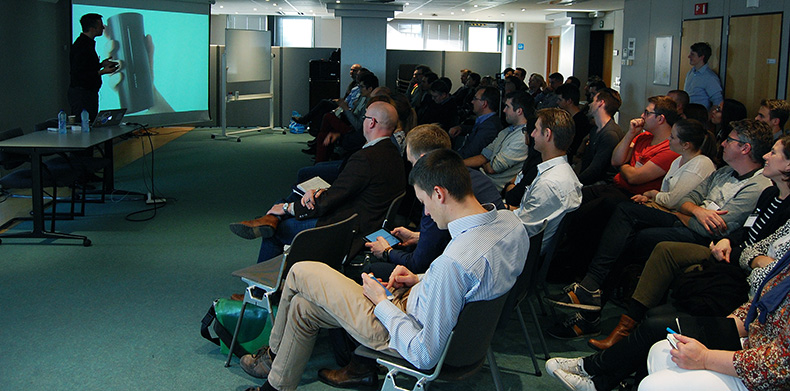Each year, on November 12th, “Usability” is celebrated worldwide.
In 2005, the official World Usability Day (www.worldusabilityday.org – WUD) was founded. It is a single day of events that occur around the world and bring together communities of professional, industrial, educational, citizen, and government groups for the betterment of our common objective: ensuring that the services and products important to life are easier to access and simpler to use.
This year, UXprobe, Internet Architects, and Studio Dott.—all Antwerp-based companies—decided to participate in that great movement. Together, we organized a “World Usability Day in Antwerp”—the only WUD event organized in Belgium!
Professionals gathered together for an afternoon seminar headed by User Experience experts Jan Moons, Dries De Roeck, and Peter Fransen. The afternoon wrapped up with a panel discussion.
•••
Since this blog post is a bit longer than usual, and contains different types of content, you might want to jump to the section that interests you. That’s why I’m sharing here the Table of Content:
- Organizing an Event – Side Benefits for a Start-Up
- Results of Our Post-Event Survey
- Who attended the WUD in Antwerp?
- The 3 talks – Quote, Outline, and Take-away
- The Panel Discussion – Introduction and Quotes
- Links to Slide Decks and Videos
1. Organizing an Event – Side Benefits for a Start-Up
First of all, I would like to share a bit of an insight.
As a start-up, UXprobe tries to use all available resources to provide good content around our domain of expertise: User Experience. This was one of the reasons why we decided to organize this event. Besides our great pride in having so many professionals gathered together around our 3 UX experts, this day was full of other side benefits. One of the most important is the friendly relationship we developed with our 2 partners: Internet Architects and Studio Dott.! It was a pleasure to work with our two new partners. We here at UXprobe feel that this is the beginning of much future collaboration. As a start-up, creating a strong and trustful network is one of our basic rules for success. Many thanks to them for their help and good advice along the way!
Last but not least, as a start-up, getting as much as help as possible becomes a way of living. In that area, our incubator—Startit@KBC—has been very supportive, especially when it comes to organizing events. Another big round of applause, thank you!
2. Results of Our Post-Event Survey
Thank you to everyone who took the time to answer the survey.
The overall satisfaction averaged 3,88 (out of 5).
The speakers and panel discussion were also rated (out of 5): Jan Moons (3,44), Dries De Roeck (4,06), Peter Fransen (3,44) and Panel discussion (3,38).
The “Net Promoter Score” could be evaluated at 84! The average rating for the question “Would you recommend attending a future World Usability Day event to a friend or colleague?” was 5,88 (out of 7).
To the question “What did you really like about the World Usability Day 2015 event?” the answers and percentages were as follows: the organization (75%), the location & the content (69%), the day and time (44%), the audience (31%).
The most recurrent comment was about the lack of interaction. Like someone said: “It was a lot of talk, which wasn’t complementary for the energy in the crowd. In order to keep the energy up, it would be better to have more interactivity.”
Probably an idea for next year: have a better balance between talks and interactive session.
If you have any other suggestions, do not hesitate to leave them in the comments.
3. Who attended the WUD in Antwerp?
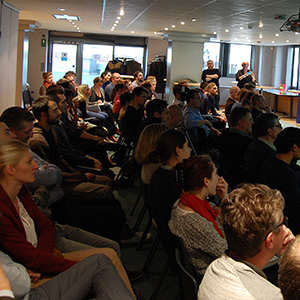 The event was attended by a wide range of professionals: account managers, business developers, digital project managers, product managers, founders, CEOs, web developers, industrial designers, product designers, UX designers, web designers, and UX researchers! This turnout shows very clearly how interdisciplinary the User Experience field is among professions. It touches a lot of different functions.
The event was attended by a wide range of professionals: account managers, business developers, digital project managers, product managers, founders, CEOs, web developers, industrial designers, product designers, UX designers, web designers, and UX researchers! This turnout shows very clearly how interdisciplinary the User Experience field is among professions. It touches a lot of different functions.
The companies represented were mostly of 2 kinds: two-thirds were agencies, specializing in digital strategy, web design, and communication or software development; the other one-third were enterprises, including the banking, government, and media or telecommunication sectors. At the margins, stood a start-up and a university.
We can easily say that Usability and User Experience directly touch people involved in the domain, which, today, means professionals developing digital products (websites, applications, software, etc.). These professionals are aware of the importance of UX. They deal with UX issues constantly, and they have already integrated UX practices into their usual workflow. Of course, they are always seeking more knowledge, use cases, and training.
However, what is probably new is the growing interest shown by bigger enterprises. Digital transformation is on its way, and large enterprises have to tackle this enormous disruption. There are many attitudes toward this fundamental change. Most of them involve, either directly or indirectly, a hint of User Experience. Digital strategies cannot be implemented without UX. Hence, a third of our attendees were either people newly hired into big companies to help with digital projects or growth or senior project managers feeling the pressure of digital change. A lot of this was considered during our panel discussion.
4. The 3 talks – Quote, Outline, and Take-away
In an afternoon, we explored a new tool to measure User Experience (Jan Moons with UXprobe), research around hybrid products (Dries De Roeck with Studio Dott.), and a use case (Peter Fransen with Internet Architects and their work on the website of the Province of Antwerp).
Jan Moons, “Beyond The Lab, Into-The-Wild Testing”
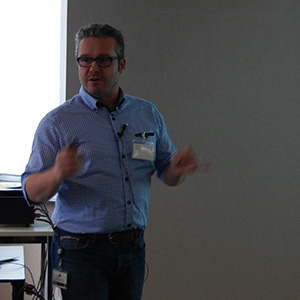 Quote:
Quote:
“Remote usability testing allows you to test in the real world with more users. When you add proper UX metrics to it, you get a full understanding of what your users do and how they feel regarding your software.”
Outline:
Today, UX testing is still done in a lab with a very small set of users. The rise of analytics services and online micro-feedback tools is changing the state of testing. It is possible now to understand how people, on a large scale, experience products in the real world. This will enable us to continuously learn from users and use their insights to make products better.
Take-away:
Yes, that tool to measure User Experience exists; Jan dreamt about it, and he built it when co-founding UXprobe. He’s still busy developing a full product. But, you can now operate un-moderated tests online directly through software or an application with UXvue. With the UXprobe system, you can simultaneously measure users’ behavior and collect feedback.
Dries de Roeck, “Hello Hybrids! A Story About Digital and Physical Products”
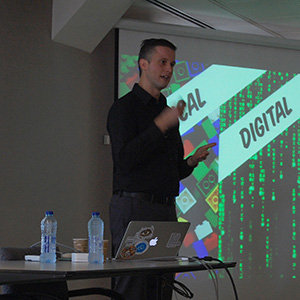 Quote:
Quote:
“Sometimes you understand things in order to design, sometimes you design things in order to understand.”
Outline:
The intertwining of digital and physical products has led to significant changes in the landscape of design. Software development has become part of hardware design and vice versa. Also, digital products allow interactions that were not imaginable before. The challenges brought to the table by these changes are central in Studio Dott’s ongoing in-house research activities.
Take-away:
Studio Dott. creates very specific tools (timelines, sets of cards) to understand their stakeholders (explore their thoughts and behaviour) before starting to design. Sometimes they also design very refined prototypes—combining digital and physical aspects—to collect accurate feedback about how stakeholders would react and use that new product. A new department—Dott. Research—has been opened to explore new areas linked to these hybrid products and the Internet of Things.
Peter Fransen, “Fighting Content Decay”
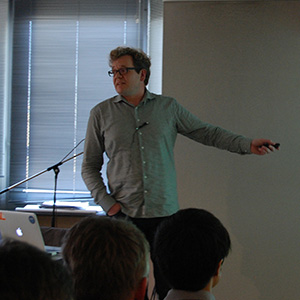 Quote:
Quote:
“Typical content problems are not that many in websites, but when the website is huge—4000 pages for example—you can’t really expect any human being to go through 4000 different pages to look for each of these problems. So we built a robot to do that for us.”
Outline:
In many large organizations, “decentralized communication” is all the rage. How can a small web team manage the content on its website when it has little control over what gets published? It can often feel like fighting a losing battle. Internet Architects has built a tool that can help them track down problems and keep tabs on the quality of the website.
Take-away:
The robot that Internet Architects built is actually a script that looks at each page of the website by following the site map. A set of 4 criteria (Content structure, Accessibility, Readability, and Performance) is used to rate each page. The rating is compared to the popularity of the page, which gives the web team an idea of which pages should be improved first. This allows a small team to maintain good content even on a very large website.
5. The Panel Discussion – Introduction and Quotes
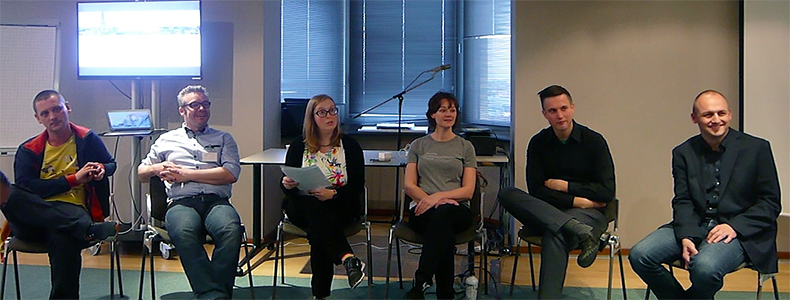 Participants (from left to right): Gwen Vanhee (Little Miss Robot), Jan Moons (UXprobe), Mieke Daniels (KBC), Annie Stewart (Internet Architects), Dries De Roeck (Studio Dott.) and Hans de Mondt (Astrata).
Participants (from left to right): Gwen Vanhee (Little Miss Robot), Jan Moons (UXprobe), Mieke Daniels (KBC), Annie Stewart (Internet Architects), Dries De Roeck (Studio Dott.) and Hans de Mondt (Astrata).
The first half hour was mostly devoted to the complexity inherent to User Experience as a discipline. UX has existed for over 20 years, but the growing scope of UX approaches makes it difficult to apprehend for non-UX people. This results in a very confusing situation that most UX professionals struggle with on a daily basis.
Nevertheless, almost everyone agrees that the confusion is just the price to be paid for the new success encountered by the UX domain. As a result, part of the job of UX professionals is to educate colleagues and customers. “My job as a UX designer is 5% designing and 95% communication and reaching consensus.”
On the same line, here are a few quotes heard during the discussion:
“30 years of UX and usability research and design: established discipline in every company or still a day-to-day struggle?”
“UX design is designing the end-to-end journey of every stakeholder involved.”
“UX is not one person’s responsibility; it’s the team’s responsibility.”
“First UX challenge: who’s responsible for what (design, product, service, etc.)? And how can we make them part of the ‘UX team’?”
“UX contributes to user-driven innovation: listening to, communicating with, and finding solutions for the user.”
“Is the UX expert the doctor presenting the unique remedy, or should we probe for feedback in a continuous way?”
“Kill the silos, kill individual roles, and work as a team.”
6. Links to Slide Decks, Videos and Pictures
Please forgive the quality of the sound of the videos, which was recorded directly with the camera, and, therefore, includes some ambient sounds also!
Jan Moons “Beyond Lab Testing: Into the Wild”
Slide deck on UX Antwerp Meetup SlideShare
Video on Youtube
Dries De Roeck “Hello Hybrids”
Slide deck on UX Antwerp Meetup SlideShare
Video on Youtube
Peter Fransen
Due to copyright constraint, Peter could not share his slide deck and nor allow a video to be recorded.
Panel Discussion
Video on Youtube
Unfortunately, we could only record the first 20 minutes of the discussion.
Pictures
ABOUT THE AUTHOR
 Isabelle Dro
Isabelle Dro
Director of Communications

